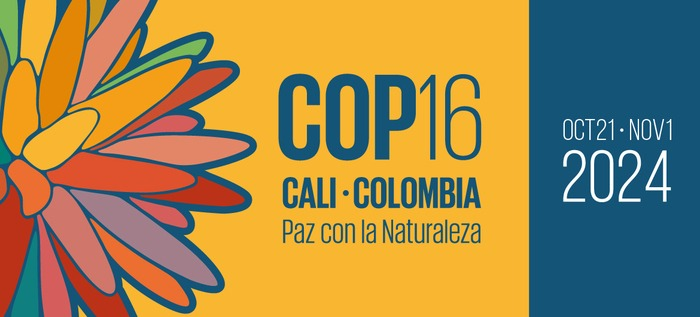- Courses
- GS Full Course 1 Year
- GS Full Course 2 Year
- GS Full Course 3 Year
- GS Full Course Till Selection
- Answer Alpha: Mains 2025 Mentorship
- MEP (Mains Enrichment Programme) Data, Facts
- Essay Target – 150+ Marks
- Online Program
- GS Recorded Course
- Polity
- Geography
- Economy
- Ancient, Medieval and Art & Culture AMAC
- Modern India, Post Independence & World History
- Environment
- Governance
- Science & Technology
- International Relations and Internal Security
- Disaster Management
- Ethics
- NCERT Current Affairs
- Indian Society and Social Issue
- NCERT- Science and Technology
- NCERT - Geography
- NCERT - Ancient History
- NCERT- World History
- NCERT Modern History
- CSAT
- 5 LAYERED ARJUNA Mentorship
- Public Administration Optional
- ABOUT US
- OUR TOPPERS
- TEST SERIES
- FREE STUDY MATERIAL
- VIDEOS
- CONTACT US
16th UN Conference of Parties (COP16) on Biological Diversity
16th UN Conference of Parties (COP16) on Biological Diversity
06-11-2024
- The 16th Conference of the Parties (COP16) to the Convention on Biological Diversity (CBD) took place in Cali, Colombia, from October 21 to November 1, 2024.
- The summit aimed to address critical global issues related to biodiversity conservation and nature protection.
- While some significant progress was made, many key issues were left unresolved, forcing countries to agree to continue negotiations at a future meeting in Bangkok in 2024.
- Theme of COP16: “Peace with Nature,” emphasizing the importance of preserving biodiversity to maintain harmony between human society and the natural world.
Background of the Convention on Biological Diversity (CBD):
Key Goals of the Kunming-Montreal Global Biodiversity Framework (KMGBF): The KMGBF, adopted at COP15, set out 23 global action-oriented targets to reverse biodiversity loss by 2030, including:
The goal of COP16 was to make progress on these targets and implement the KMGBF. |
Key Developments and Breakthroughs at COP16
1. Introduction of a Global Tax on Genetic Data (Cali Fund):
- Genetic data from nature (called Digital Sequence Information, or DSI) is increasingly used in products like medicines but has often been accessed without payment.
- A major agreement at COP16 was the decision to introduce a global tax on companies that profit from using this data.
- Criteria for Companies: Companies will need to meet two out of 3 criteria:
- Sales of over $50 million.
- Profits of over $5 million.
- $20 million in total assets.
- Contribution to DSI Fund: Companies meeting these criteria will have to contribute 1% of their profits or 0.1% of their revenue to the DSI fund.
- Potential Fund Size: The fund could raise more than £1 billion (about $1.25 billion) each year for nature conservation.
- Benefit to Indigenous Communities: At least 50% of the fund will go to Indigenous communities involved in conservation work, ensuring that poorer countries benefit from the use of their natural resources.
2. Permanent Role for Indigenous and Local Communities:
- For the 1st time in history, Indigenous peoples and local communities were granted a permanent role in UN biodiversity decision-making.
- This change ensures that these groups have a formal voice in biodiversity negotiations, rather than depending on governments to represent their interests.
- Afro-descendant communities, particularly in the Americas, were also given formal recognition in decision-making processes.
3. Synthetic Biology:
- A new thematic action plan on synthetic biology was introduced, focusing on capacity-building, technology transfer, and knowledge-sharing to help developing countries address the inequities in this rapidly growing field.
- Synthetic biology refers to the engineering of new organisms or modifications to existing organisms using technologies like DNA sequencing and genome editing.
4. Global Action Plan on Biodiversity and Health:
- A Global Action Plan was approved to address the emergence of zoonotic diseases.
- It promotes human health, and encourages sustainable ecosystems through a One Health Approach, which recognizes the interconnected health of humans, animals, and ecosystems.
Key Failures and Missed Opportunities at COP16:
1. Failure to Meet the $200 Billion Annual Funding Target:
- One of the major goals of COP16 was to finalize a plan to raise $200 billion annually by 2030 to protect biodiversity.
- However, no clear plan was agreed upon.
- The $20 billion annual pledge by wealthier countries to support poorer nations in biodiversity protection also remained unmet, causing frustration, especially from developing countries.
2. No Agreement on New Financial Mechanisms for Biodiversity:
- Developing countries, especially in Africa and Brazil, pushed for a new system to distribute biodiversity funds, separate from the current Global Environment Facility (GEF) system.
- The existing GEF is often seen as difficult to access and controlled by wealthier nations. However, no agreement was reached on this issue.
3. Monitoring and Accountability:
- Another critical issue that remained unresolved was how to effectively monitor progress on the 23 biodiversity targets set at COP15.
- A draft monitoring framework was under discussion but was not finalized, leaving countries without a system to track whether targets are being met.
India’s Contribution at COP16:
India played a prominent role at COP16, highlighting its strong commitment to biodiversity conservation:
1. Updated National Biodiversity Strategy and Action Plan (NBSAP):
- India launched an updated NBSAP to align with the Kunming-Montreal Global Biodiversity Framework (KMGBF).
India’s Updated National Biodiversity Strategy and Action Plan (NBSAP) 2024-2030
|
2. Financial Investments in Biodiversity:
- India committed to spending ₹81,664 crore (around $10 billion) on biodiversity and conservation from 2025 to 2030.
- Between 2018 and 2022, India invested ₹32,207 crore (around $4 billion) in biodiversity and conservation.
- India emphasized the need for international financial support to meet the ambitious targets outlined in the KMGBF, including the goal of raising $200 billion annually for biodiversity protection.
3. Conservation Initiatives:
- India highlighted its commitment to wildlife conservation through initiatives like the International Big Cat Alliance, which focuses on protecting seven major big cat species.
- India also reported a significant increase in the number of Ramsar sites, wetlands of international importance. The number of Ramsar sites in India has risen from 26 in 2014 to 85 today, with plans to reach 100 soon.
Challenges and Criticism of COP16 Negotiations:
1. Time Constraints and Legitimacy:
- Many delegates from developing countries, such as Fiji, had to leave early due to financial constraints, which impacted the legitimacy of some key decisions.
- Concerns were raised about the lack of quorum for important votes, potentially undermining the agreements made during the summit.
2. Weak Leadership from Wealthier Nations:
- Critics, including Oscar Soria of the Common Initiative think tank, accused wealthier nations such as the EU, China, Canada, Switzerland, Japan, and the UK of not showing the necessary leadership to take concrete actions.
- These countries had been instrumental in setting ambitious targets at COP15, but failed to take decisive action at COP16 to implement those targets.
3. Disappointment over Financial Commitments:
- Environmental organizations like WWF expressed disappointment over the lack of progress on financial commitments.
- The $200 billion annual funding goal and the $20 billion pledge for poorer countries were not achieved, leaving the biodiversity crisis underfunded and unresolved.
About Convention on Biological Diversity (CBD):
Key Features of the CBD:
Major Meetings & Milestones:
Other Key Points:
|
Must Check: Best IAS Coaching In Delhi
UPSC Prelims Result 2024 Out: Expected Cut Off & Other Details, UPSC Prelims 2024 Answer with Explanation, Daily Prelims Quiz, Daily Current Affairs, MONTHLY CURRENT AFFAIRS TOTAL (CAT) MAGAZINE, Best IAS Coaching Institute in Karol Bagh, Best IAS Coaching Institute in Delhi, Daily Mains Question Answer Practice, ENSURE IAS UPSC Toppers, UPSC Toppers Marksheet, Previous Year Interview Questions, UPSC Syllabus





